
- SAP Community
- Products and Technology
- Technology
- Technology Blogs by Members
- SAP HANA SLT - Performance Tuning on customer deve...
- Subscribe to RSS Feed
- Mark as New
- Mark as Read
- Bookmark
- Subscribe
- Printer Friendly Page
- Report Inappropriate Content
In this post, I would like to share one of my project experience on performance tuning for Customer developed ABAP program from 38% improvement to 260%+ improvement after implemented SAP HANA SLT side car.
I will share some of the techniques for using sap transactions (SCI, SE30, etc) to analyze the performance bottleneck for further improvement with screens shoot captured from my work in the past which I had helped to implement SAP HANA SLT and fine tuning a customer developed report ZFI05SBL with side car.
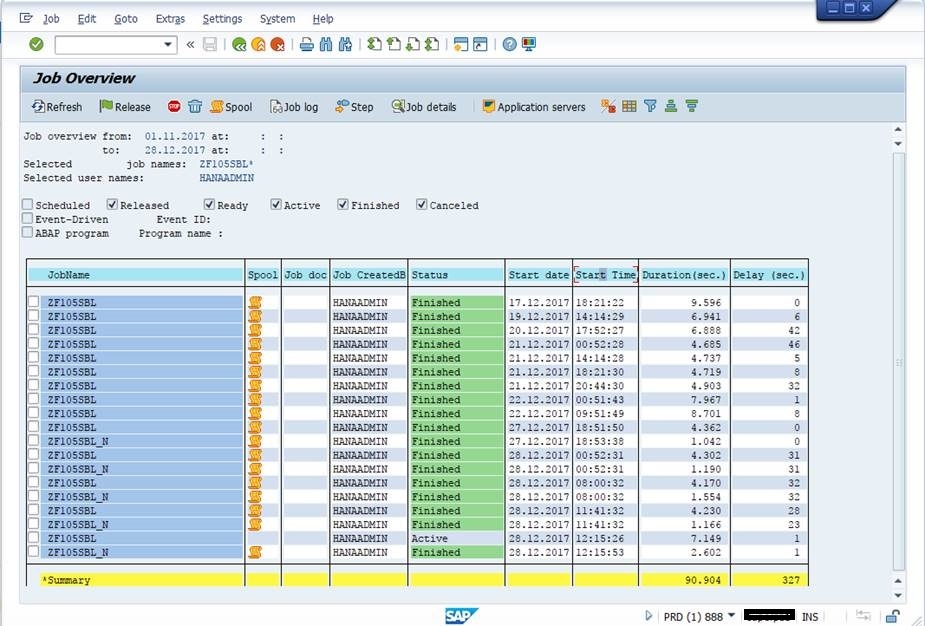
Background - Performance Measure for customer program after implement SLT
Remark: ZFI05SBL (original program before tuning); ZFI05SBL_N (revision program tuned for SAP HANA SLT Side car)

Background: We found that there was only a slight improvement on performance (i.e. 38% - 40%) after implement side car with SAP HANA SLT for the initial performance measure for customer developed program.
Since the customer wasn't happy about the result and refused to sign-off UAT, I had used SAP transactions SCI, SE30, ST05 for analyzed the performance bottleneck and identify the area for further improvement.
Analysis Step 1 - Checking from Basis perspective
Before we jump into application analysis and tuning, I would suggest to start performance analysis on some basic area. (i.e. system configuration, parameter settings, etc) which is important as sometimes incorrect / non-optimal configuration in system setting may cause application performance degrade.
Most of the time, I would start using SM66 or SM50 to monitor the SAP processes running in the SAP system and view the details of the processes which I suspect with performance bottleneck that had been running for long time.
You may check for following:
- Actions running
- Records update
- Activities
- Memory statistic
(Tips 1: Heap Memory à lack of memory on ABAP instance)
(Tips 2: If program running for long time without records increases, this may be due to bottleneck on database resource.)
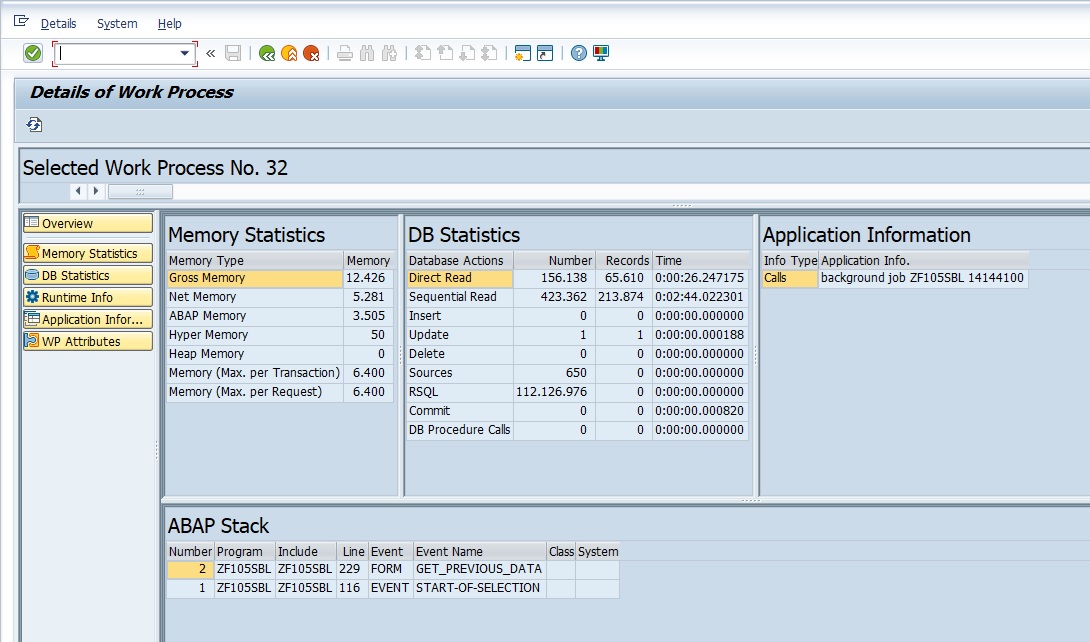
Example: Use SM50 / SM66 to review Memory Statistic & DB statistic for long running processes
In addition, I also reviewed the SAP HANA database replication processes and found that there were times that the replication processes were pending on HANA database during non-office hours.
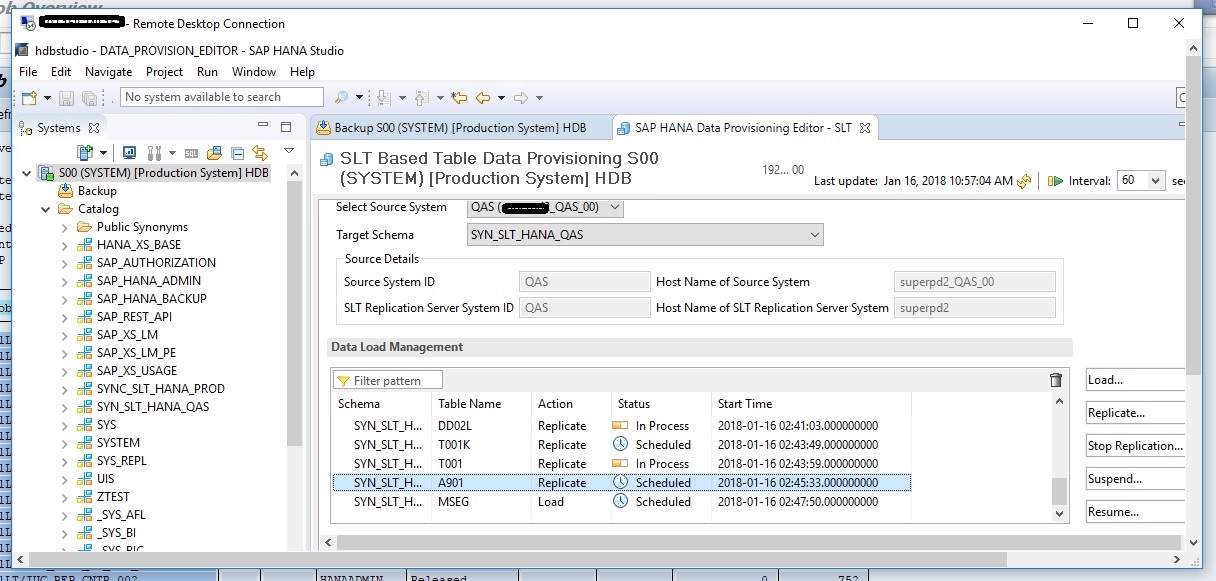
Example: Found SAP HANA SLT process pending

Example: SM37 - Found replication job were in delay status
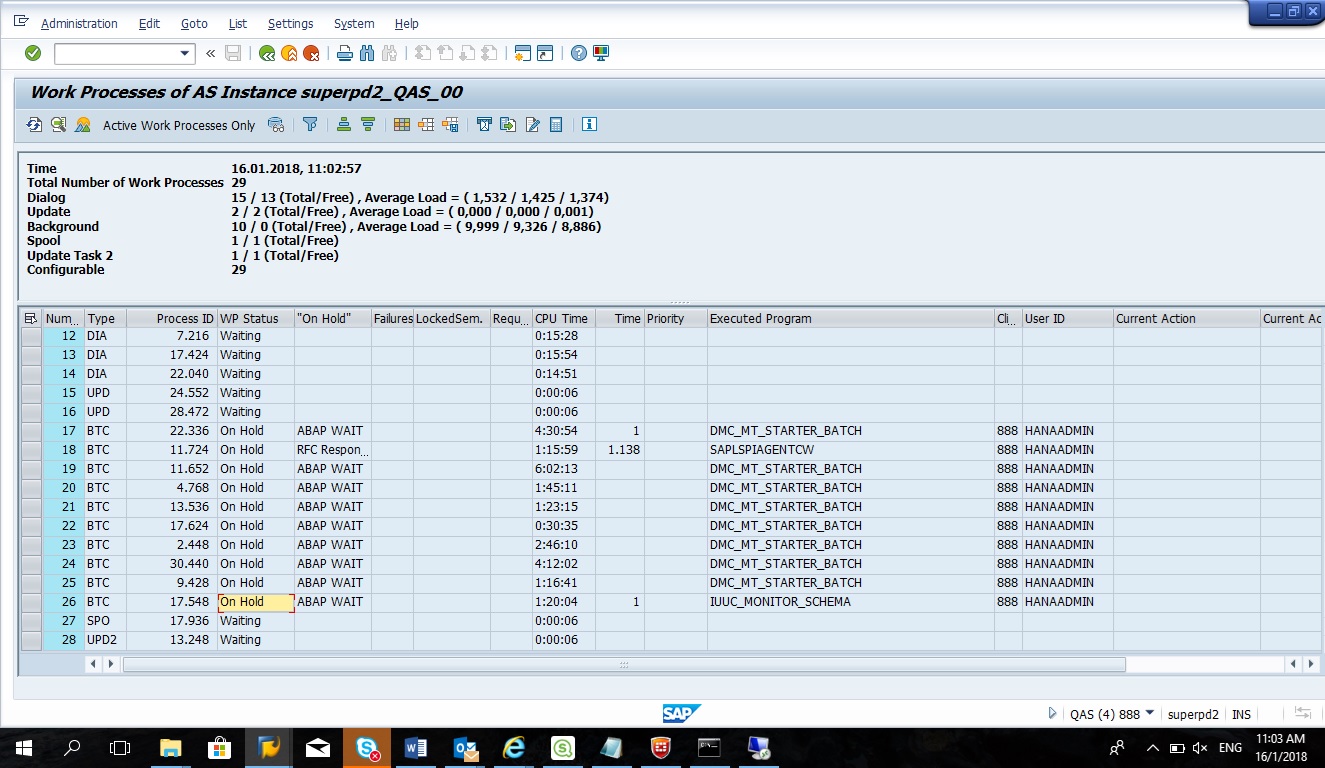
Example: Check SM50 and found BTC processes were fully occupied during non-office hours
Finding 1 - Example: Replication Process pending & delayed due to lack of background process
After checking the SM37 and SM50, I found that replication job had been delayed due to all background processes had been occupied during table replications in the non-office hours.
Therefore, I had tuned the system parameters in SAP operation mode (Tcode: RZ03) for increase number of work processes for background jobs and fine tuned the SAP HANA SLT replication server parameters.
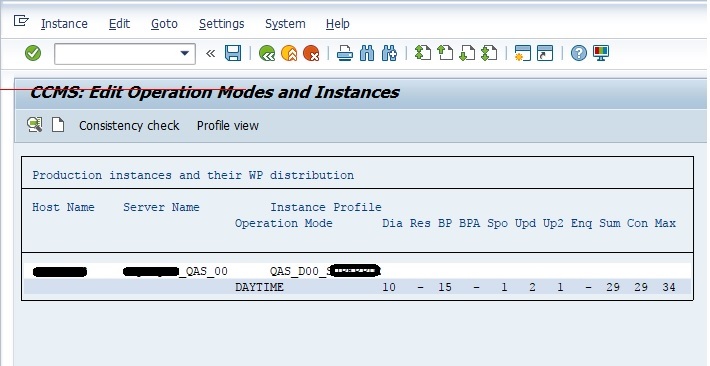
Example: RZ03 - Increase BTC process in operation mode
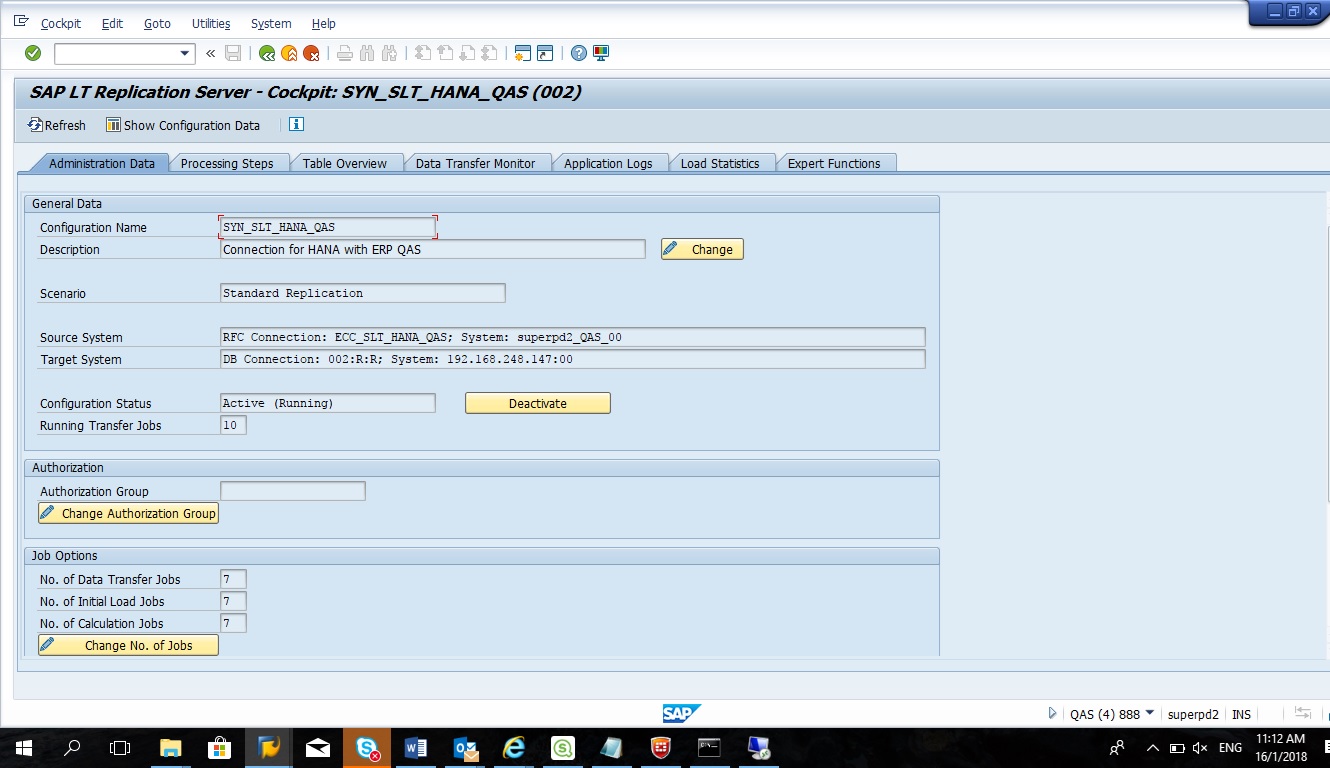
Example: Tuning SAP LT Replication Server parameter
Analysis Step 2 - Capture original program performance as baseline
After we confirmed that the system configuration and resources is optimal, we may start to measure the customer developed program performance before tuning as baseline figures.
I had used 2 transaction ST03N and SM37 for measure the program execution time.

Example: ST03N - Workload Analysis (Transaction Profile)
Workload Analysis (ST03N)
I used transaction ST03N Transaction profile for review performance before and after SLT HANA replication and ABAP accelerator and checked for program behavior before switch the program to run on HANA database table. These figures can be used for troubleshoot and use for identify performance bottleneck.
Job Overview (SM37)
I used transaction SM37 to review the job execution time before and after using SAP LT replication on HANA wand ABAP accelerator.

Example: Program variant used for performance test
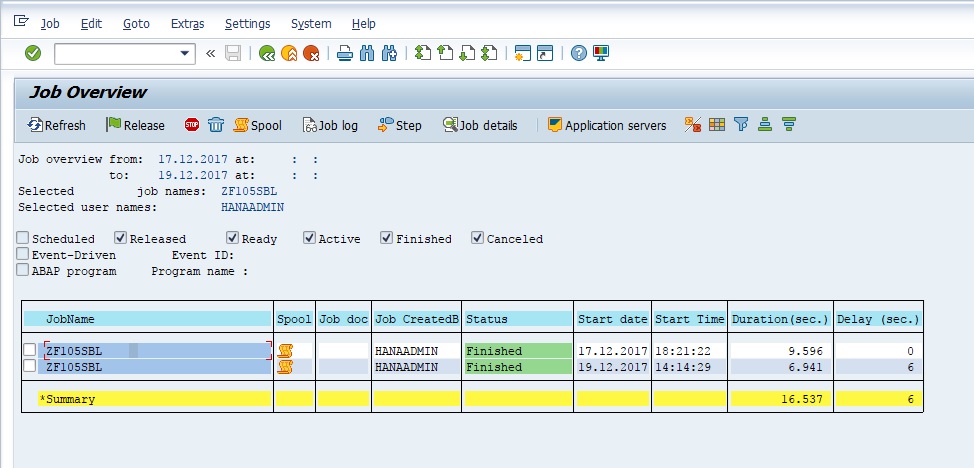
Example: Use SM37 to measure program execution time
We found that the performance is improved if retrieved data with 3 months and 8 site for this report.
Time 1:
Original Execution Time: 9596
Time 2:
SLT Execution Time: 6941
((T2 / T1) – 1 ) * 100 = 38%
The 1st testing result is improved 38% for replicate tables on KONP, MARA, MBEW and MBEWH
Since we see that the performance is not improved a lot with ABAP Accelerator and SAP LT HANA replication. We perform the code inspection for this program to check for area need to be tuned.
Analysis Step 3 - SAP Code Inspector
I had used the SAP Code Inspector for analyzed the customer developed program for identify the program code required performance tuning.
You may refer to the attached URL of another article for view the detail steps on using SCI (SAP Code Inspector) for performance analysis. I am not going to repeat the basic steps here.
Reference URL for the article https://blogs.sap.com/2016/01/18/mandatory-steps-to-adapt-abap-code-for-sap-hana/

Example: Create Check Variant for SAP Code Inspector

Example: Review SAP Code Inspector result
Finding 2 - Example found some SQL statement are checking on some tables not replicated with SLT.
I had reviewed the SAP code inspector result and identified that there are some code required tuning for optimal performance for running in SAP HANA. In addition, I also found that some of the tables used in where clause filter had not replicated to SLT. Therefore, I had added the tables for replication and tuned the ABAP code per SAP recommendation.
- Update ABAP Code per SAP recommendation for code change in HANA environment.
- Include the tables for SLT replication and side car
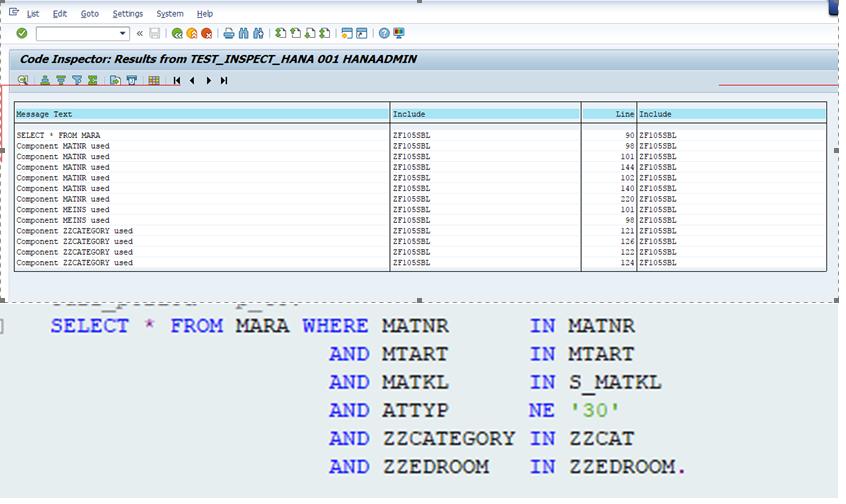
Example: Sample Tuning - Revised coding per SAP recommendation on HANA platform
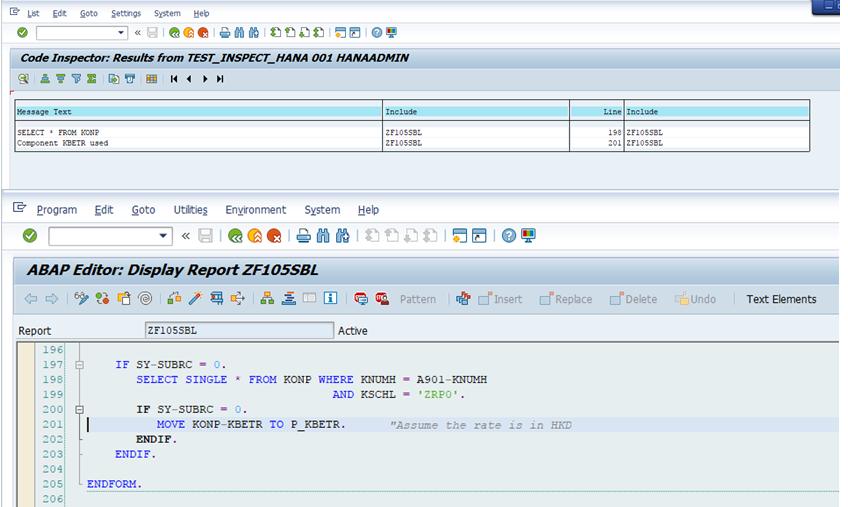
Example: Sample Tuning - Revised the statement and include the condition records tables into SAP SLT replication.

Example: Sample Tuning - Check the statement and ensure inner join table are included in SAP LT replications.
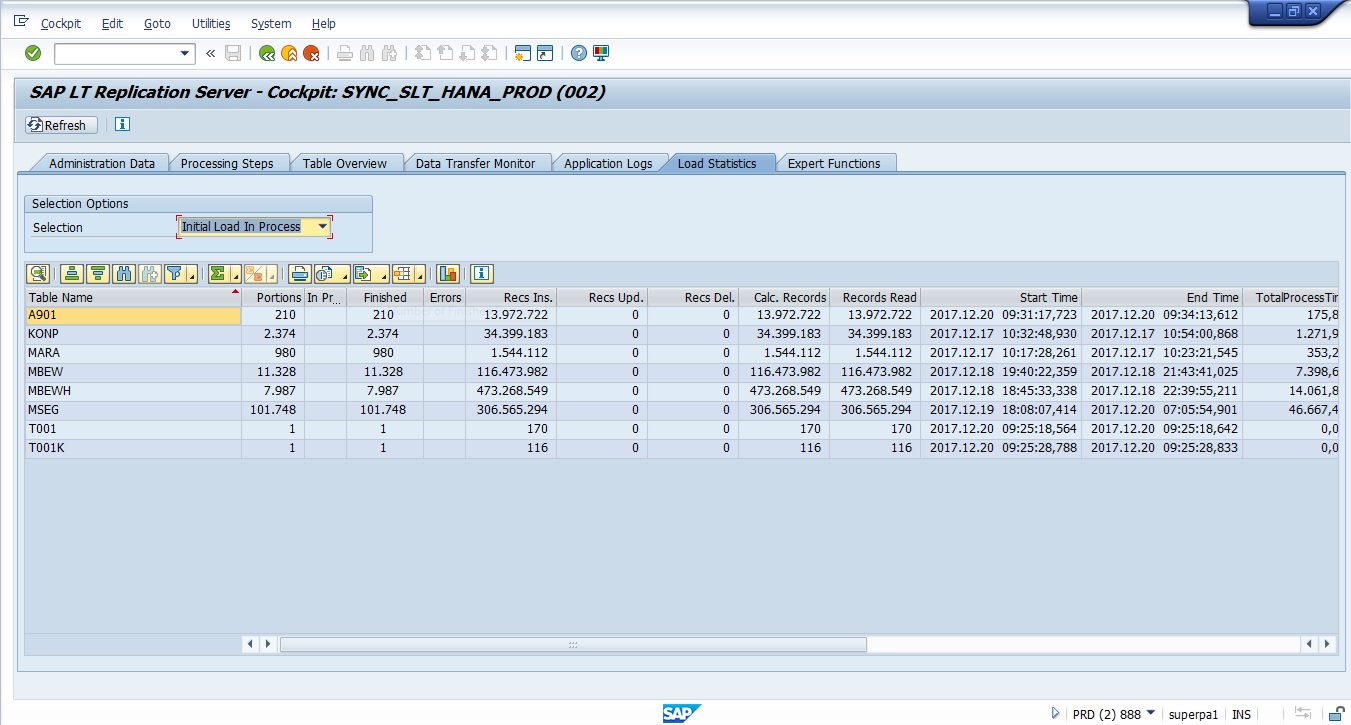
Example: Sample Tuning - Included the tables used in inner join for SAP LT replication

Example: Sample Tuning - Included the table for side car
Review Program execution time after tuning
After performed the tuning, I had execute the program with SM37 at different timeslot with same program variant selection to verify the performance had improved after tuning.
This time I found that the program execution time had improved around 95% to 104% for 3rd to 6th round of testing in different timeslot.
| No. | Time 1 | Time 2 | Ratio | % Improvement |
| 1st Round | 9596 | 6941 | 1.38 | 38.25% |
| 2nd Round | 9596 | 6888 | 1.39 | 39.31% |
| 3rd Round | 9596 | 4685 | 2.05 | 104.82% |
| 4th Round | 9596 | 4737 | 2.03 | 102.58% |
| 5th Round | 9596 | 4719 | 2.03 | 103.35% |
| 6th Round | 9596 | 4903 | 1.96 | 95.72% |
Remark: Calculation of % of Improvement: ((T2/T1) – 1 * 100%)
1st - 2nd round – execution after using activate ABAP accelerator.
3rd – 6th round – execute after tuning by adding additional tables for push down database operations to HANA database.

Example: Use SM37 to review program execution time after tuning
Review ABAP Analysis (SE30)
Although I had verified that the program execution time had improved, I had further checked the ABAP program with transaction SE30 for identified the area can be further fine tuned.
Tips: I usually check on the Net(%) for identify the area should be review for further improvement.
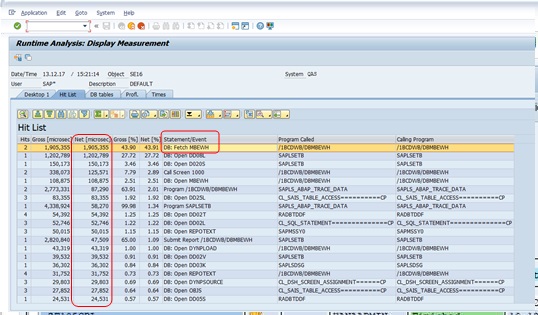
Example: Review SE30 ABAP Analysis result
Final Review in program execution time after deployment to production system
At last we had compared the original program and the fine tuned program in production system.
We measured the program execution time between original program and the fine tuned side car version using identical program variant for selection and found significant improvement as below for 8th to 12th round of the performance testing.
| No. | Time 1 | Time 2 | Ratio | % Improvement |
| 1st Round | 9596 | 6941 | 1.38 | 38.25% |
| 2nd Round | 9596 | 6888 | 1.39 | 39.31% |
| 3rd Round | 9596 | 4685 | 2.05 | 104.82% |
| 4th Round | 9596 | 4737 | 2.03 | 102.58% |
| 5th Round | 9596 | 4719 | 2.03 | 103.35% |
| 6th Round | 9596 | 4903 | 1.96 | 95.72% |
| 7th Round | 9596 | 7967 | 1.20 | 20.45% |
| 8th Round | 9596 | 1042 | 9.21 | 820.92% |
| 9th Round | 9596 | 1190 | 8.06 | 706.39% |
| 10th Round | 9596 | 1554 | 6.18 | 517.50% |
| 11th Round | 9596 | 1166 | 8.23 | 722.98% |
| 12th Round | 9596 | 2602 | 3.69 | 268.79% |

Example: Use SM37 to review program execution in production system.
Remark: ZFI055SBL is original program; ZFI055SBL_N is the tuned side car version with SAP HANA SLT.
In conclusion, we may improve the customer developed program using SAP HANA SLT (side car) with optimal setting in replication server & SAP server.
Summary of the sample tuning task for this demonstration:
- Basis Tuning: Increased the process for the SAP LT Replication Jobs and reviewed parameter tuning for SAP HANA and SAP System
- ABAP Tuning: Change the ABAP code per SAP recommendation on HANA platform
- Included the transaction tables, master data table (i.e. condition records, etc) used for inner join and lookup in the SAP SLT Replications for ensure the optimal performance.
- Configured Side car to use replicated tables.
I hope this blog can help you with your SAP HANA SLT project in future.
- SAP Managed Tags:
- SAP HANA,
- SAP Landscape Transformation,
- Basis Technology
You must be a registered user to add a comment. If you've already registered, sign in. Otherwise, register and sign in.
-
"automatische backups"
1 -
"regelmäßige sicherung"
1 -
505 Technology Updates 53
1 -
ABAP
14 -
ABAP API
1 -
ABAP CDS Views
2 -
ABAP CDS Views - BW Extraction
1 -
ABAP CDS Views - CDC (Change Data Capture)
1 -
ABAP class
2 -
ABAP Cloud
2 -
ABAP Development
5 -
ABAP in Eclipse
1 -
ABAP Platform Trial
1 -
ABAP Programming
2 -
abap technical
1 -
access data from SAP Datasphere directly from Snowflake
1 -
Access data from SAP datasphere to Qliksense
1 -
Accrual
1 -
action
1 -
adapter modules
1 -
Addon
1 -
Adobe Document Services
1 -
ADS
1 -
ADS Config
1 -
ADS with ABAP
1 -
ADS with Java
1 -
ADT
2 -
Advance Shipping and Receiving
1 -
Advanced Event Mesh
3 -
AEM
1 -
AI
7 -
AI Launchpad
1 -
AI Projects
1 -
AIML
9 -
Alert in Sap analytical cloud
1 -
Amazon S3
1 -
Analytical Dataset
1 -
Analytical Model
1 -
Analytics
1 -
Analyze Workload Data
1 -
annotations
1 -
API
1 -
API and Integration
3 -
API Call
2 -
Application Architecture
1 -
Application Development
5 -
Application Development for SAP HANA Cloud
3 -
Applications and Business Processes (AP)
1 -
Artificial Intelligence
1 -
Artificial Intelligence (AI)
4 -
Artificial Intelligence (AI) 1 Business Trends 363 Business Trends 8 Digital Transformation with Cloud ERP (DT) 1 Event Information 462 Event Information 15 Expert Insights 114 Expert Insights 76 Life at SAP 418 Life at SAP 1 Product Updates 4
1 -
Artificial Intelligence (AI) blockchain Data & Analytics
1 -
Artificial Intelligence (AI) blockchain Data & Analytics Intelligent Enterprise
1 -
Artificial Intelligence (AI) blockchain Data & Analytics Intelligent Enterprise Oil Gas IoT Exploration Production
1 -
Artificial Intelligence (AI) blockchain Data & Analytics Intelligent Enterprise sustainability responsibility esg social compliance cybersecurity risk
1 -
ASE
1 -
ASR
2 -
ASUG
1 -
Attachments
1 -
Authorisations
1 -
Automating Processes
1 -
Automation
1 -
aws
2 -
Azure
1 -
Azure AI Studio
1 -
B2B Integration
1 -
Backorder Processing
1 -
Backup
1 -
Backup and Recovery
1 -
Backup schedule
1 -
BADI_MATERIAL_CHECK error message
1 -
Bank
1 -
BAS
1 -
basis
2 -
Basis Monitoring & Tcodes with Key notes
2 -
Batch Management
1 -
BDC
1 -
Best Practice
1 -
bitcoin
1 -
Blockchain
3 -
BOP in aATP
1 -
BOP Segments
1 -
BOP Strategies
1 -
BOP Variant
1 -
BPC
1 -
BPC LIVE
1 -
BTP
11 -
BTP Destination
2 -
Business AI
1 -
Business and IT Integration
1 -
Business application stu
1 -
Business Architecture
1 -
Business Communication Services
1 -
Business Continuity
1 -
Business Data Fabric
3 -
Business Partner
12 -
Business Partner Master Data
10 -
Business Technology Platform
2 -
Business Trends
1 -
CA
1 -
calculation view
1 -
CAP
2 -
Capgemini
1 -
Catalyst for Efficiency: Revolutionizing SAP Integration Suite with Artificial Intelligence (AI) and
1 -
CCMS
2 -
CDQ
12 -
CDS
2 -
Cental Finance
1 -
Certificates
1 -
CFL
1 -
Change Management
1 -
chatbot
1 -
chatgpt
3 -
CL_SALV_TABLE
2 -
Class Runner
1 -
Classrunner
1 -
Cloud ALM Monitoring
1 -
Cloud ALM Operations
1 -
cloud connector
1 -
Cloud Extensibility
1 -
Cloud Foundry
3 -
Cloud Integration
6 -
Cloud Platform Integration
2 -
cloudalm
1 -
communication
1 -
Compensation Information Management
1 -
Compensation Management
1 -
Compliance
1 -
Compound Employee API
1 -
Configuration
1 -
Connectors
1 -
Conversion
1 -
Cosine similarity
1 -
cryptocurrency
1 -
CSI
1 -
ctms
1 -
Custom chatbot
3 -
Custom Destination Service
1 -
custom fields
1 -
Customer Experience
1 -
Customer Journey
1 -
Customizing
1 -
Cyber Security
2 -
Data
1 -
Data & Analytics
1 -
Data Aging
1 -
Data Analytics
2 -
Data and Analytics (DA)
1 -
Data Archiving
1 -
Data Back-up
1 -
Data Governance
5 -
Data Integration
2 -
Data Quality
12 -
Data Quality Management
12 -
Data Synchronization
1 -
data transfer
1 -
Data Unleashed
1 -
Data Value
8 -
database tables
1 -
Datasphere
2 -
datenbanksicherung
1 -
dba cockpit
1 -
dbacockpit
1 -
Debugging
2 -
Delimiting Pay Components
1 -
Delta Integrations
1 -
Destination
3 -
Destination Service
1 -
Developer extensibility
1 -
Developing with SAP Integration Suite
1 -
Devops
1 -
Digital Transformation
1 -
Documentation
1 -
Dot Product
1 -
DQM
1 -
dump database
1 -
dump transaction
1 -
e-Invoice
1 -
E4H Conversion
1 -
Eclipse ADT ABAP Development Tools
2 -
edoc
1 -
edocument
1 -
ELA
1 -
Embedded Consolidation
1 -
Embedding
1 -
Embeddings
1 -
Employee Central
1 -
Employee Central Payroll
1 -
Employee Central Time Off
1 -
Employee Information
1 -
Employee Rehires
1 -
Enable Now
1 -
Enable now manager
1 -
endpoint
1 -
Enhancement Request
1 -
Enterprise Architecture
1 -
ETL Business Analytics with SAP Signavio
1 -
Euclidean distance
1 -
Event Dates
1 -
Event Driven Architecture
1 -
Event Mesh
2 -
Event Reason
1 -
EventBasedIntegration
1 -
EWM
1 -
EWM Outbound configuration
1 -
EWM-TM-Integration
1 -
Existing Event Changes
1 -
Expand
1 -
Expert
2 -
Expert Insights
1 -
Fiori
14 -
Fiori Elements
2 -
Fiori SAPUI5
12 -
Flask
1 -
Full Stack
8 -
Funds Management
1 -
General
1 -
Generative AI
1 -
Getting Started
1 -
GitHub
8 -
Grants Management
1 -
groovy
1 -
GTP
1 -
HANA
5 -
HANA Cloud
2 -
Hana Cloud Database Integration
2 -
HANA DB
1 -
HANA XS Advanced
1 -
Historical Events
1 -
home labs
1 -
HowTo
1 -
HR Data Management
1 -
html5
8 -
idm
1 -
Implementation
1 -
input parameter
1 -
instant payments
1 -
integration
3 -
Integration Advisor
1 -
Integration Architecture
1 -
Integration Center
1 -
Integration Suite
1 -
intelligent enterprise
1 -
Java
1 -
job
1 -
Job Information Changes
1 -
Job-Related Events
1 -
Job_Event_Information
1 -
joule
4 -
Journal Entries
1 -
Just Ask
1 -
Kerberos for ABAP
8 -
Kerberos for JAVA
8 -
Launch Wizard
1 -
Learning Content
2 -
Life at SAP
1 -
lightning
1 -
Linear Regression SAP HANA Cloud
1 -
local tax regulations
1 -
LP
1 -
Machine Learning
2 -
Marketing
1 -
Master Data
3 -
Master Data Management
14 -
Maxdb
2 -
MDG
1 -
MDGM
1 -
MDM
1 -
Message box.
1 -
Messages on RF Device
1 -
Microservices Architecture
1 -
Microsoft Universal Print
1 -
Middleware Solutions
1 -
Migration
5 -
ML Model Development
1 -
Modeling in SAP HANA Cloud
8 -
Monitoring
3 -
MTA
1 -
Multi-Record Scenarios
1 -
Multiple Event Triggers
1 -
Neo
1 -
New Event Creation
1 -
New Feature
1 -
Newcomer
1 -
NodeJS
1 -
ODATA
2 -
OData APIs
1 -
odatav2
1 -
ODATAV4
1 -
ODBC
1 -
ODBC Connection
1 -
Onpremise
1 -
open source
2 -
OpenAI API
1 -
Oracle
1 -
PaPM
1 -
PaPM Dynamic Data Copy through Writer function
1 -
PaPM Remote Call
1 -
PAS-C01
1 -
Pay Component Management
1 -
PGP
1 -
Pickle
1 -
PLANNING ARCHITECTURE
1 -
Popup in Sap analytical cloud
1 -
PostgrSQL
1 -
POSTMAN
1 -
Process Automation
2 -
Product Updates
4 -
PSM
1 -
Public Cloud
1 -
Python
4 -
Qlik
1 -
Qualtrics
1 -
RAP
3 -
RAP BO
2 -
Record Deletion
1 -
Recovery
1 -
recurring payments
1 -
redeply
1 -
Release
1 -
Remote Consumption Model
1 -
Replication Flows
1 -
Research
1 -
Resilience
1 -
REST
1 -
REST API
1 -
Retagging Required
1 -
Risk
1 -
Rolling Kernel Switch
1 -
route
1 -
rules
1 -
S4 HANA
1 -
S4 HANA Cloud
1 -
S4 HANA On-Premise
1 -
S4HANA
3 -
S4HANA_OP_2023
2 -
SAC
10 -
SAC PLANNING
9 -
SAP
4 -
SAP ABAP
1 -
SAP Advanced Event Mesh
1 -
SAP AI Core
8 -
SAP AI Launchpad
8 -
SAP Analytic Cloud Compass
1 -
Sap Analytical Cloud
1 -
SAP Analytics Cloud
4 -
SAP Analytics Cloud for Consolidation
1 -
SAP Analytics Cloud Story
1 -
SAP analytics clouds
1 -
SAP BAS
1 -
SAP Basis
6 -
SAP BODS
1 -
SAP BODS certification.
1 -
SAP BTP
20 -
SAP BTP Build Work Zone
2 -
SAP BTP Cloud Foundry
5 -
SAP BTP Costing
1 -
SAP BTP CTMS
1 -
SAP BTP Innovation
1 -
SAP BTP Migration Tool
1 -
SAP BTP SDK IOS
1 -
SAP Build
11 -
SAP Build App
1 -
SAP Build apps
1 -
SAP Build CodeJam
1 -
SAP Build Process Automation
3 -
SAP Build work zone
10 -
SAP Business Objects Platform
1 -
SAP Business Technology
2 -
SAP Business Technology Platform (XP)
1 -
sap bw
1 -
SAP CAP
1 -
SAP CDC
1 -
SAP CDP
1 -
SAP Certification
1 -
SAP Cloud ALM
4 -
SAP Cloud Application Programming Model
1 -
SAP Cloud Integration for Data Services
1 -
SAP cloud platform
8 -
SAP Companion
1 -
SAP CPI
3 -
SAP CPI (Cloud Platform Integration)
2 -
SAP CPI Discover tab
1 -
sap credential store
1 -
SAP Customer Data Cloud
1 -
SAP Customer Data Platform
1 -
SAP Data Intelligence
1 -
SAP Data Services
1 -
SAP DATABASE
1 -
SAP Dataspher to Non SAP BI tools
1 -
SAP Datasphere
9 -
SAP DRC
1 -
SAP EWM
1 -
SAP Fiori
2 -
SAP Fiori App Embedding
1 -
Sap Fiori Extension Project Using BAS
1 -
SAP GRC
1 -
SAP HANA
1 -
SAP HCM (Human Capital Management)
1 -
SAP HR Solutions
1 -
SAP IDM
1 -
SAP Integration Suite
9 -
SAP Integrations
4 -
SAP iRPA
2 -
SAP Learning Class
1 -
SAP Learning Hub
1 -
SAP Odata
2 -
SAP on Azure
1 -
SAP PartnerEdge
1 -
sap partners
1 -
SAP Password Reset
1 -
SAP PO Migration
1 -
SAP Prepackaged Content
1 -
SAP Process Automation
2 -
SAP Process Integration
2 -
SAP Process Orchestration
1 -
SAP S4HANA
2 -
SAP S4HANA Cloud
1 -
SAP S4HANA Cloud for Finance
1 -
SAP S4HANA Cloud private edition
1 -
SAP Sandbox
1 -
SAP STMS
1 -
SAP SuccessFactors
2 -
SAP SuccessFactors HXM Core
1 -
SAP Time
1 -
SAP TM
2 -
SAP Trading Partner Management
1 -
SAP UI5
1 -
SAP Upgrade
1 -
SAP-GUI
8 -
SAP_COM_0276
1 -
SAPBTP
1 -
SAPCPI
1 -
SAPEWM
1 -
sapmentors
1 -
saponaws
2 -
SAPUI5
4 -
schedule
1 -
Secure Login Client Setup
8 -
security
9 -
Selenium Testing
1 -
SEN
1 -
SEN Manager
1 -
service
1 -
SET_CELL_TYPE
1 -
SET_CELL_TYPE_COLUMN
1 -
SFTP scenario
2 -
Simplex
1 -
Single Sign On
8 -
Singlesource
1 -
SKLearn
1 -
soap
1 -
Software Development
1 -
SOLMAN
1 -
solman 7.2
2 -
Solution Manager
3 -
sp_dumpdb
1 -
sp_dumptrans
1 -
SQL
1 -
sql script
1 -
SSL
8 -
SSO
8 -
SuccessFactors
1 -
SuccessFactors Time Tracking
1 -
Sybase
1 -
system copy method
1 -
System owner
1 -
Table splitting
1 -
Tax Integration
1 -
Technical article
1 -
Technical articles
1 -
Technology Updates
1 -
Technology Updates
1 -
Technology_Updates
1 -
Threats
1 -
Time Collectors
1 -
Time Off
2 -
Tips and tricks
2 -
Tools
1 -
Trainings & Certifications
1 -
Transport in SAP BODS
1 -
Transport Management
1 -
TypeScript
1 -
unbind
1 -
Unified Customer Profile
1 -
UPB
1 -
Use of Parameters for Data Copy in PaPM
1 -
User Unlock
1 -
VA02
1 -
Vector Database
1 -
Vector Engine
1 -
Visual Studio Code
1 -
VSCode
1 -
Web SDK
1 -
work zone
1 -
workload
1 -
xsa
1 -
XSA Refresh
1
- « Previous
- Next »
- Consume Ariba APIs using Postman in Technology Blogs by SAP
- Deep dive into Q4 2023, What’s New in SAP Cloud ALM for Implementation Blog Series in Technology Blogs by SAP
- SAP Cloud Integration: Understanding the XML Digital Signature Standard in Technology Blogs by SAP
- Recap - SAP ALM at SAP Insider Las Vegas 2024 in Technology Blogs by SAP
- Overview: SAP Ariba SSO with SAP Cloud Identity Services - Identity Authentication in Technology Blogs by SAP
| User | Count |
|---|---|
| 8 | |
| 8 | |
| 7 | |
| 6 | |
| 4 | |
| 4 | |
| 4 | |
| 4 | |
| 3 | |
| 3 |